
Abstract
Sum of Ranking Differences is an innovative statistical method that ranks competing solutions based on a reference point. The latter might arise naturally, or can be aggregated from the data. We provide two case studies to feature both possibilities. Apportionment and districting are two critical issues that emerge in relation to democratic elections. Theoreticians invented clever heuristics to measure malapportionment and the compactness of the shape of the constituencies, yet, there is no unique best method in either cases. Using data from Norway and the US we rank the standard methods both for the apportionment and for the districting problem. In case of apportionment, we find that all the classical methods perform reasonably well, with subtle but significant differences. By a small margin the Leximin method emerges as a winner, but—somewhat unexpectedly—the non-regular Imperiali method ties for first place. In districting, the Lee-Sallee index and a novel parametric method the so-called Moment Invariant performs the best, although the latter is sensitive to the function’s chosen parameter.
https://journals.plos.org/plosone/article?id=10.1371/journal.pone.0229209
Nem található esemény a közeljövőben.
A KRTK Közgazdaság-tudományi Intézet teljesítményéről A KRTK KTI a RePEc/IDEAS rangsorában, amely a világ közgazdaság-tudományi tanszékeit és intézeteit rangsorolja publikációs teljesítményük alapján, a legjobb ... Read More »

Tisztelt Kollégák! Tudományos kutatóként, intézeti vezetőként egész életünkben a kutatói szabadság és felelősség elve vezetett bennünket. Meggyőződésünk, hogy a tudomány csak akkor érhet el ... Read More »

Srí Lanka: a 2022-es gazdasági válság leckéje – A. Krueger Lessons from Sri Lanka Anne O. Krueger Jul 25, 2022 – Project Syndicate ... Read More »

A permanens válság korában élünk – J. Meadway We’re living in an age of permanent crisis – let’s stop planning for a ‘return ... Read More »

A 2021 végén, illetve 2022 elején tapaszalt 6, illetve 7%-os cserearányromlás brutális reáljövedelem-kivonást jelentett a magyar gazdaságból. A külső egyensúly alakulásával foglalkozó elemzések többnyire ... Read More »
